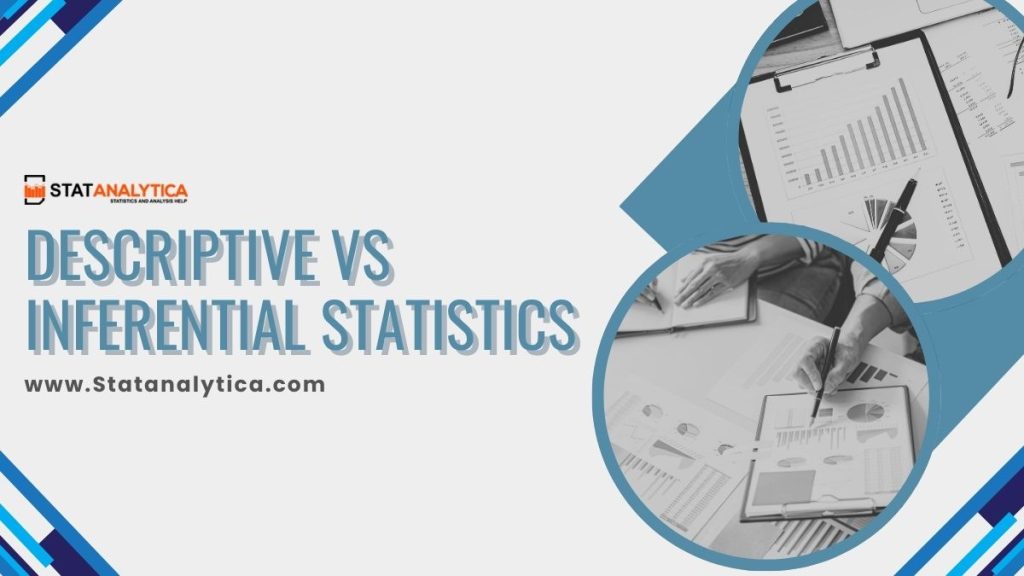In an era where data drives decision-making in almost every field, understanding statistics is more crucial than ever. Statistics allows individuals and businesses to analyze information, identify patterns, and make informed decisions based on evidence. At the core of statistical analysis are two main branches: descriptive vs inferential statistics.
While descriptive statistics focus on summarizing and organizing data, inferential statistics take it a step further, using that data to make predictions and draw conclusions. Both play an essential role in data analysis, with unique methods and applications that can influence how data is interpreted and used.
In this blog, we will discuss Descriptive Vs Inferential Statistics, but before directly proceeding, let’s first understand the definitions of each.
What is Descriptive Statistics?
Table of Contents
Descriptive statistics is a field of statistics focused on organizing and summarizing data. By focusing on a dataset’s core characteristics, descriptive statistics helps analysts understand what the data shows at a glance. This type of statistics is often used when a complete set of data is available, and the need is to make that data easier to understand without concluding the dataset itself.
Key Components
Central Tendency
Central tendency measures summarize data by identifying a central point. Common measures include:
Mean: The average of all data points.
Median: The middle value in a sorted data set.
Mode: The most frequently occurring value(s).
Dispersion
Dispersion measures show how data is spread out, indicating the amount of variation from the central values.
Range: The range is found by subtracting the smallest value from the largest value in a dataset.
Variance: Variance measures how spread out the values are by averaging the squared differences from the mean.
Standard Deviation: The square root of the variance, indicating how data values deviate from the mean.
Distribution
The distribution of data shows how data points are spread over a range, often visualized with charts.
Histograms: Bar charts that represent frequency distributions.
Frequency Tables: Tables that show the number of times each value occurs.
Examples in Real-Life Contexts
Summarizing Test Scores
A school can use descriptive statistics to summarize students’ test scores, providing an overall view of performance without interpreting the results.
Survey Data Analysis
Companies often use descriptive statistics to summarize customer feedback, identifying average satisfaction levels or common issues.
What is Inferential Statistics?
Inferential statistics is the branch of statistics used to make predictions, draw conclusions, and infer trends about a larger population based on a sample of data. Unlike descriptive statistics, inferential statistics allow analysts to go beyond the data on hand, applying statistical techniques to predict and generalize findings.
Key Techniques
Hypothesis Testing
Hypothesis testing assesses whether the data in a sample provides sufficient evidence to conclude that a specific condition applies to the whole population.
T-tests: It is used to evaluate and compare the average values between two different groups.
Chi-Square Test: Used to compare categorical data for two or more groups.
Confidence Intervals
Confidence intervals provide a range of values within which the true population parameter is likely to fall, with a specified level of confidence (e.g., 95%).
Regression Analysis
Regression analysis examines the relationship between variables, allowing predictions for one variable based on known values of another.
Linear Regression: Used to predict a dependent variable based on the relationship with an independent variable.
Examples in Real-Life Contexts
Population Trend Predictions
Demographers use inferential statistics to estimate population growth rates based on samples.
Market Forecasting
Businesses apply inferential methods to predict future market demand or customer behavior based on sample surveys.
Descriptive Vs Inferential Statistics: Key Differences You Should Know
Outlined below is a detailed comparison between descriptive and inferential statistics presented in a tabular format. This table highlights their core purposes, methods, data requirements, and applications, offering a clear understanding of when and how each type is used in data analysis.-
| Aspect | Descriptive Statistics | Inferential Statistics |
| Definition | Provides a summary and highlights key characteristics within a dataset. | Draws conclusions or predictions about a larger population by analyzing a sample. |
| Purpose | Provides a clear summary of data, highlighting patterns without generalization. | Extends results from a sample to represent a broader population, supporting informed decision-making. |
| Data Requirements | Uses entire datasets to present information. | Requires sample data to represent the population. |
| Key Components | Measures of central tendency (mean, median, mode), measures of spread (range, variance, standard deviation), and data distribution. | Hypothesis testing, confidence intervals, regression analysis |
| Scope of Analysis | Limited to the dataset on hand, without extending to generalizations beyond it. | Extends analysis beyond the dataset, allowing predictions and hypothesis testing. |
| Application Of Statistics Examples | Summarizing survey results, describing test scores, and visualizing data distributions. | Market forecasting, population trend predictions, testing relationships between variables |
| Decision-Making Role | Helps to understand and describe data clearly, aiding immediate insights. | Enables proactive decision-making based on probability and predicted outcomes. |
| Challenges | Risk of oversimplifying data, leading to potential misinterpretation. | Vulnerable to sampling errors and biases, impacting the accuracy of predictions. |
| Common Visuals | Histograms, bar charts, pie charts, frequency tables | Statistical graphs based on analysis (e.g., confidence interval graphs, regression lines) |
When to Use Descriptive Vs Inferential Statistics?
Project Goals
Descriptive statistics are ideal for projects focused on summarizing and understanding the specific data available. They help analysts and stakeholders observe central tendencies, variations, and data distributions, providing clear and immediate insights into existing data without making predictions. Examples include summarizing customer feedback scores, monthly sales figures, or survey responses to create a clear view of trends.
Conversely, if the project aims to go beyond mere observation—such as testing hypotheses, forecasting trends, or concluding a larger population from a sample—then inferential statistics are the more suitable choice. For instance, inferential methods are used in studies predicting market growth, clinical trial efficacy, or consumer behavior trends, where conclusions need to extend to a broader group based on sampled data.
Sample Size
Descriptive statistics can be applied to datasets of any size, from small to large, because their purpose is to organize and summarize the specific data available. This flexibility makes them useful across varied scenarios, whether analyzing a sample or a complete dataset. For example, descriptive statistics are applicable and effective in reporting the average scores of a classroom test or the total sales for a year.
Inferential statistics, however, generally require a sample that accurately represents a larger population to make valid generalizations. Sample size and representativeness are crucial here since inferential statistics rely on concluding the entire population. For example, political polling or predicting product success requires carefully selected samples to ensure that the findings are meaningful and applicable to the broader audience.
Decision-Making
Descriptive statistics support decision-makers by providing a comprehensive view of the data at hand, enabling well-informed decisions based on current information. They offer clarity by summarizing complex datasets, helping to identify patterns or trends useful for immediate insights. For example, a retail company might use descriptive statistics to review past sales performance and set short-term strategies.
In contrast, inferential statistics allow decision-makers to make proactive, forward-looking choices. They provide insights based on probability and trends, supporting decisions about future actions, potential risks, or opportunities. For instance, businesses use inferential statistics to estimate future demand, guide product development, or evaluate customer preferences, using sample data to predict larger market behavior.
Common Challenges in Using Descriptive Vs Inferential Statistics
Data Misinterpretation
Descriptive statistics can be easily misinterpreted if not analyzed with proper context. Since they summarize raw data, there’s a risk of oversimplification, where averages or other metrics may not capture the full picture or may lead to misleading conclusions. For instance, reporting an average income in a highly unequal society could hide the extremes and misrepresent economic realities. Properly defining and contextualizing the data is crucial to avoid these misunderstandings and to ensure accurate communication of findings.
Sampling Errors and Bias
Inferential statistics are particularly sensitive to sampling errors and biases, which can compromise the accuracy and reliability of conclusions. For instance, if the sample is not representative of the broader population due to poor sampling methods or inherent biases, the inferences made could be flawed, leading to incorrect predictions or ineffective decisions. Common issues include selection bias, where certain groups are over or under-represented, and sampling error, where the sample might not fully capture the diversity of the population. Ensuring representative samples and minimizing bias through randomized sampling and other robust methods is essential for valid inferential analyses.
Conclusion
Understanding the differences between Descriptive Vs Inferential Statistics can guide analysts and decision-makers in selecting the best methods for their data analysis tasks. Descriptive statistics provide clear, immediate insights into data, while inferential statistics allow predictions, enabling organizations to make informed decisions based on probable outcomes. By using each type of statistic effectively, analysts can ensure more comprehensive and accurate data insights.
FAQs
Why are inferential statistics important?
Inferential statistics are important for making predictions, testing hypotheses, and understanding relationships between variables in a population based on sample data.
How does sampling affect inferential statistics?
Sampling is essential for inferential statistics because it enables generalization from a sample to a population, though sample quality and size impact accuracy.


